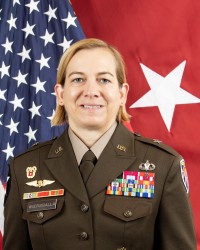Mission Statement: The U.S. Army’s premier communications provider with global reach, the 7th Signal Command enables the Army's ability to build, train, compete, fight, and win across complex Joint & Coalition Multi- and All-Domain environments.
Executes theater-level DODIN operations; plans and delivers continual improvements to the Unified Network to provide the CONUS digital infrastructure required by National Leaders, the Joint Force, and the Army for data-driven operations and decision making.
Commander's Vision: The 7th Signal Command operates as a people-centered organization, built on the foundational elements of personal character, mutual trust, and unwavering commitment to duty, all of which are underscored by high levels of operational and technical competence.
7th Signal Command (Theater) Leadership
-
 7th Signal Command (Theater) Commanding GeneralBG Anne-Marie R. Wiersgalla
7th Signal Command (Theater) Commanding GeneralBG Anne-Marie R. Wiersgalla -
 7th Signal Command (Theater) Command Sergeant MajorCSM Katrina L. Richardson
7th Signal Command (Theater) Command Sergeant MajorCSM Katrina L. Richardson -
 Deputy CommanderCOL Jason Kendzierski
Deputy CommanderCOL Jason Kendzierski -
 7th Signal Command (Theater) Acting Civilian Deputy to the Commanding GeneralDr. James E. Cronkhite
7th Signal Command (Theater) Acting Civilian Deputy to the Commanding GeneralDr. James E. Cronkhite -
 7th Signal Command (Theater) Command Chief Warrant OfficerCW5 Eric J. Gray
7th Signal Command (Theater) Command Chief Warrant OfficerCW5 Eric J. Gray -
 7th Signal Command (Theater) Chief of StaffCOL Michael A. Duval
7th Signal Command (Theater) Chief of StaffCOL Michael A. Duval
7th Signal Command (Theater) was activated on 1 July 1975 at Fort Ritchie, Maryland and tasked to oversee and support all CONUS signal operations, complementing 5th Signal Command in Europe and 6th Signal Command in the Pacific. The Command provided communications, automation, visual information, printing and publications, and records management services to CONUS Army units.
7th Signal Command (Theater) was deactivated on 1 October 1993 and its functional support components were redistributed to Fort Detrick, Maryland and several other posts. On 22 July 2008, 7th Signal Command (Theater) was reactivated at Fort Eisenhower, Georgia as part of the “Grow the Army" initiative. Its commander at reactivation was Brigadier General Jennifer Napper. On 1 September 2021, 7th Signal Command (Theater) Headquarters re-stationed its operational components to Fort Meade, Maryland, increasing ARCYBER’s lethality and the readiness and capability of DODIN-A Operations for the Army. The Command's support components remain at Fort Eisenhower.
7th Signal Command’s three subordinate Signal Brigades are 93d Signal Brigade, headquartered at Fort Eustis, Virginia; the 106th Signal Brigade at Fort Sam Houston, Texas; and the 21st Signal Brigade at Fort Detrick, Maryland.
The 93rd Signal Brigade was originally constituted as the 93d Signal Battalion on 3 November 1941 and activated on 15 May 1942 at Camp Crowder, Missouri. 93d Signal Battalion departed New York aboard the Queen Elizabeth and arrived in England on 26 April 1944. Shortly after its arrival, The Battalion shipped out for France to support forces deployed to Normandy. 93d Signal Battalion served in Luxemburg for the duration of the Ardennes Campaign and deployed into Germany on 9 March 1945 until the end of the war.
On 22 December 1945, 93d Signal Battalion left Europe aboard the Texarkana Victory Ship en route to Hampton Roads, Virginia. Shortly after their arrival, 93d Signal Battalion was inactivated at Camp Patrick Henry, Virginia on 3 January 1946. 93d Signal Battalion was called back to active duty on 24 February 1955 at Fort Huachuca, Arizona and one decade later it was inactivated on 21 September 1972.
93d Signal Brigade was activated again in Germany on 16 March 1981. The Brigade then deployed to Saudi Arabia in 1990 with 7th (VII) Corps in support of Operations Desert Shield and Desert Storm. The unit deactivated along with 7th (VII) Corps after Desert Shield and Desert Storm.
In February 1998, 93d Signal Brigade was activated once again at Fort Eisenhower, Georgia, where it would remain for almost 10 years. Elements of the Brigade deployed multiple times in support of the Global War on Terrorism, particularly Operation Iraqi Freedom I, II, and III. 93d Signal Brigade was deactivated and reflagged as the 35th Signal Brigade on 16 April 2007. In 2008, 93d Signal Brigade would again call Fort Eustis, Virginia its home, this time with a new mission as part of the newly formed 7th Signal Command (Theater).
93d Signal Brigade honors include Campaign streamers for participation in World War II, Northern France, Rhineland, Ardennes-Alsace, Central Europe, Southwest Asia, Defense of Saudi Arabia; liberation and defense of Kuwait; and the cease-fire ending Operation Desert Storm.
The 106th Signal Brigade traces its history back to Birmingham Army Air Base located in Alabama, where it was constituted as the 932d Signal Battalion and activated on 15 February 1943 with the mission of supporting Army Air Corps operations. In April 1944, the 932d was reorganized and re-designated as the 932d Signal Battalion, which served in Europe during World War II earning 5 Campaign streamers.
The unit returned to the United States in October of 1945 and was inactivated at Camp Kilmer, New Jersey. The 932d was activated again on 12 August 1963 at Camp Des Loges, France and re-designated as Headquarters and Headquarters Detachment, 106th Signal Group, as part of U.S. Army Europe. It was later assigned to U.S. Army Strategic Communications Command on 1 July 1964.
The 932d was relocated to Stuttgart, Germany in March, 1967 and later inactivated in November, 1967. On 16 October 1991, the 106th was reactivated, in Corozal, Panama, re-designated as the 106th Signal Brigade, and assigned to U.S. Army Information Systems Command (USAISC) providing strategic and tactical communications support to the U.S. Army South (USARSO) and U.S. Southern Command (SOUTHCOM). The brigade was later inactivated in October 1997 as part of the provisions of the Panama Treaty.
On 16 July 2008, the 106th Signal Brigade was reorganized and reactivated at Fort Sam Houston, Texas, as part of the 7th Signal Command (Theater), with a mission to secure and defend the western portion of the LandWarNet in CONUS.
The 21st Signal Brigade began as the 21st Signal Group, activated on 1 September 1965 at Fort Liberty, North Carolina. The 21st Signal Group provided area signal communications support throughout 10,000 square miles of the I and II Corps tactical zones in South Vietnam, participated in 13 campaigns during the Vietnam War from 1966-1971, and was awarded the Meritorious Unit Commendation. It was inactivated on 27 November 1971 at Fort Lewis, Washington. Effective 16 October 2003, the 1108th Signal Brigade, a remaining element of the inactivated 7th Signal Command, was redesignated as the 21st Signal Brigade at Fort Detrick, Maryland.
On 1 June 2010, the 21st Signal Brigade was reassigned from 9th Signal Command (Army) to 7th Signal Command (Theater). The brigade's mission is to conduct network operations for theater-based LandWarNet communications systems, networks, and enterprise services, and provide and defend global information capabilities to enable joint and combined Battle Command from the President of the United States to the Warfighter during full spectrum operations.
News
-
 7th Signal Command (Theater) HHC delivers holiday cheer with Angel Tree gift drive
December 12, 2025
7th Signal Command (Theater) HHC delivers holiday cheer with Angel Tree gift drive
December 12, 2025
-
 21st Theater Signal Brigade holds change of responsibility ceremony
September 8, 2025
21st Theater Signal Brigade holds change of responsibility ceremony
September 8, 2025
-
 7th Signal Command (Theater) G-1 Staff Ride Inspires, Educates, and Honors the Legacy of Army HR
July 24, 2025
7th Signal Command (Theater) G-1 Staff Ride Inspires, Educates, and Honors the Legacy of Army HR
July 24, 2025
-
 Brig. Gen. Anne-Marie Wiersgalla Assumes Command of 7th Signal Command (Theater)
June 26, 2025
Brig. Gen. Anne-Marie Wiersgalla Assumes Command of 7th Signal Command (Theater)
June 26, 2025
-
 Col. Glenroy Haskins assumes command of 93d Theater Signal Brigade
June 18, 2025
Col. Glenroy Haskins assumes command of 93d Theater Signal Brigade
June 18, 2025
-
 LEGACY OF SERVICE: 7th Signal Command's Acting Civilian Deputy Reflects on Daughter's Navy Career
April 30, 2025
LEGACY OF SERVICE: 7th Signal Command's Acting Civilian Deputy Reflects on Daughter's Navy Career
April 30, 2025
5 Things to Know | December 2023 | U.S. Army
21st Theater Signal Brigade
-
 CommanderCOL John Sanders
CommanderCOL John Sanders -
 Command Sergeant MajorCSM Cesar Ruiz
Command Sergeant MajorCSM Cesar Ruiz
93d Theater Signal Brigade
-
 CommanderCOL Glenroy Haskins
CommanderCOL Glenroy Haskins -
 Command Sergeant MajorCSM Melanie Coronado
Command Sergeant MajorCSM Melanie Coronado
93d Signal Brigade
106th Theater Signal Brigade
-
 CommanderCOL Chante Pondexter
CommanderCOL Chante Pondexter -
 Command Sergeant MajorCSM Joshua Miles
Command Sergeant MajorCSM Joshua Miles
7th Signal Command (Theater) Jobs
Available Jobs: USAJOBS - Search.
Helpful Links
- Incoming Soldiers | CAC Required
- US Army Network Enterprise Command
- Army Cyber Command
- Defense Travel System
- Army Training Network
- Fort Meade Homepage
- Fort Eisenhower Homepage
- 7th Signal Command Facebook
- 7th Signal Command LinkedIn
- 7th Signal Command Instagram
- 21st Signal Brigade
- 93d Signal Brigade
- 106th Signal Brigade








